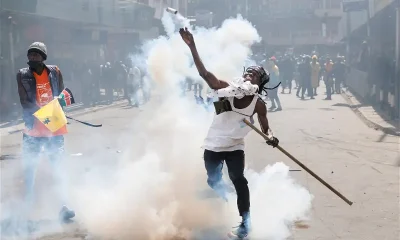
Foreign
Journalist Wanjeri Kariuki’s Harrowing Ordeal: Shot While Covering Nakuru Protests

NAKURU, (iexclusivenews) In a disturbing turn of events that highlights the dangers faced by journalists in conflict zones, Catherine Wanjeri Kariuki, a dedicated reporter for Kameme TV, found herself in the crosshairs of violence during recent anti-government protests in Nakuru, Kenya.
This incident has not only shed light on the risks journalists face but also raised serious questions about press freedom and police conduct in the country.

A Day That Changed Everything
What began as a routine assignment for Wanjeri quickly spiraled into a life-threatening situation. On that fateful day, she left her home at 1:30 PM, expecting to cover the protests and return safely.
Little did she know that her commitment to journalistic duty would lead to a horrifying experience and a hospital stay.
Despite wearing a jacket clearly marked “PRESS,” Wanjeri became a target.

In a shocking turn of events, she was shot four times with rubber bullets, three of which lodged in her body.
The incident occurred while she stood among journalists from various media houses, raising questions about whether she was deliberately singled out.
Disturbingly, this was not Wanjeri’s first brush with police brutality.
She recounted a previous incident where she was struck by a tear gas canister, leaving a scar on the same leg that was later shot.
This pattern of targeting suggests a troubling trend of aggression towards members of the press.
READ MORE: Kenya In Turmoil As Deadly Protests Shake Ruto’s Government
Kenya Erupts Again As Mass Protests Challenge Ruto’s Presidency
An Act of Kindness Met with Violence
In a cruel twist of irony, moments before being shot, Wanjeri was captured on camera offering toothpaste to a police officer to alleviate the effects of tear gas.
This compassionate gesture makes the subsequent violence against her even more shocking and inexplicable.
Currently admitted at Annex Hospital, Wanjeri is recovering from surgery to remove the rubber bullets from her thigh.
While doctors assure that she is out of immediate danger, the long-term physical and emotional impacts of this traumatic experience remain uncertain.
A Call for Justice and Accountability
Through tears, Wanjeri bravely called out the National Police Service, asserting her belief that they know the identity of the officer who shot her.
Her powerful statement, “I know justice will be served to me,” resonates as a rallying cry for accountability and the protection of journalists.
This incident raises serious concerns about the state of press freedom in Kenya and the safety of journalists covering sensitive political events.
It underscores the urgent need for better protection mechanisms for media personnel and stricter oversight of law enforcement actions during protests.
As Wanjeri begins her journey of recovery, her story serves as a stark reminder of the risks journalists face in pursuit of truth.
It calls for a reevaluation of protocols to protect members of the press and ensure that such incidents do not recur in the future.
A Testament to Journalistic Courage
Wanjeri Kariuki’s ordeal is a powerful testament to the courage and dedication of journalists who risk their lives to bring important stories to light.
As she heals, her experience serves as a catalyst for crucial conversations about press freedom, police accountability, and the fundamental right to information in a democratic society.




























